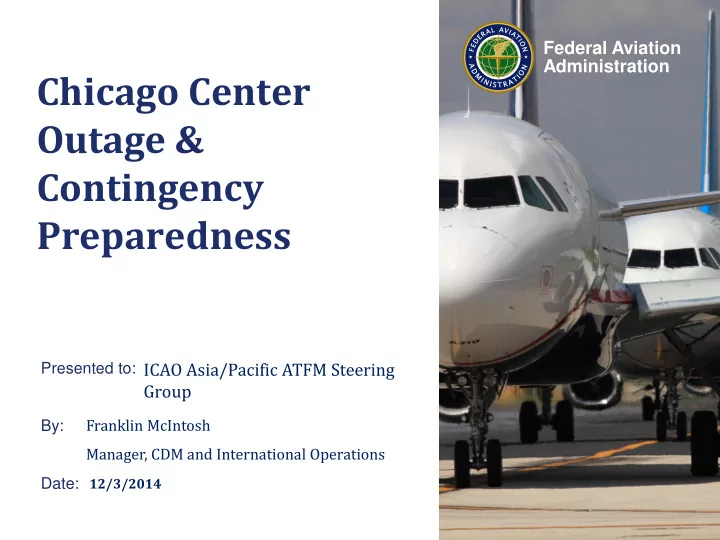

Federal Aviation Administration Chicago Center Outage & Contingency Preparedness ICAO Asia/Pacific ATFM Steering Presented to: Group Franklin McIntosh By: Manager, CDM and International Operations 12/3/2014 Date:
Contingency plans are developed with the hopes that they will never require long term implementation Friday, September 26, 2014 @ 1048Z • The Command Center Received the initial call that Chicago Center was “losing everything” – ATC ZERO • ZAU Averages 7400 operations daily • ORD Averages 2700 operations daily • Immediately Command Center issued an ALL + Canada Ground stop for all flights inbound to Chicago Center airspace including O’Hare and Midway airports. • Coordination with NAVCANADA began for the use of the CAN-ROUTES • Command Center issued reroutes for all TRANSCON flights and regional routes were utilized to move flights around Chicago Center Airspace. • Ad-hoc teleconferences were started at the command center due to traditional landlines being out of service. Federal Aviation 12/5/2014 Administration
Insert Movie Federal Aviation 12/5/2014 Administration
Focusing on O’Hare & Midway Airports • Once we realized this would be a LONG term event, we began to evaluate the Chicago area volume specifically O’Hare and Midway airports. • Flow Constrained Areas were developed and remained in place for the duration of the outage to monitor the traffic volume levels at O’Hare and Midway airports. • Initially internal ZAU departures landing O’Hare and Midway were routed via “TEC” or Tower ENROUTE Clearance. This is a TRACON to TRACON routing differing from the normal TRACON to ARTCC to TRACON routing. • This TEC Route structure was eventually expanded and utilized for ALL flights transitioning through lower altitude airspace into O’Hare and Midway Airports. This was a drastic change to the normal routings into and out of Chicago TRACON airspace. Flights would be kept at 10,000 feet until they could exit the sidewall or lateral boundaries under what WAS Chicago Center airspace. • This CAP and TUNNEL strategy would be more expensive in fuel costs to the stakeholders, but would allow flights to continue to move in and out of the Chicago area; even if at reduced volume levels. • Eventually the adjacent TRACON vertical limits would raise to 15,000, C90 to 17,000 Federal Aviation 12/5/2014 Administration
Federal Aviation 12/5/2014 Administration
Absorbing ZAU Airspace • As we continued to divide ZAU airspace to the adjacent centers, we continued to use Flow Constrained Area and Flow En-route Area tools to monitor the volume. • Controllers were transferring responsibilities into newly designed airspace and we used test flights to check the validity of radio and radar coverage before we increased through put volume levels. • As we continued through the event and air traffic controllers became more comfortable working the newly redesigned airspace, we strategically increased the through put volume levels into O’Hare and Midway airports through the use of Airspace Flow Programs. We worked diligently through collaboration to ensure demand was kept on the airports and sectors without compromising safety. Federal Aviation 12/5/2014 Administration
EXIT STRATEGY • Now how do we return ZAU to Normal Operations? • What does that now look like? • Develop a strategic plan: • A Step-by-Step process with a timeline • Flight planning changes • When to expect holding and the duration • Disseminate it (3 days prior) • EXECUTE Federal Aviation 12/5/2014 Administration
KEYS TO SUCCESS • FULL Collaboration with our stakeholders at EVERY step • Airlines representatives brought into the Command Center EMC room, which was used as a staging area • Ensure everyone participates in discussions and planning • Back-up Plan B & C available and ready to implement • Disseminate information UP and DOWN the landscape • FAA Leadership was briefed twice per day (by the Director) • Stakeholders were briefed every 2 hours (by the Air Traffic Manager) Federal Aviation 12/5/2014 Administration
THANK YOU Franklin J. McIntosh Manager, CDM and International Operations FAA Command Center (540)422-4130 Franklin.McIntosh@FAA.gov Federal Aviation 12/5/2014 Administration
Recommend
More recommend